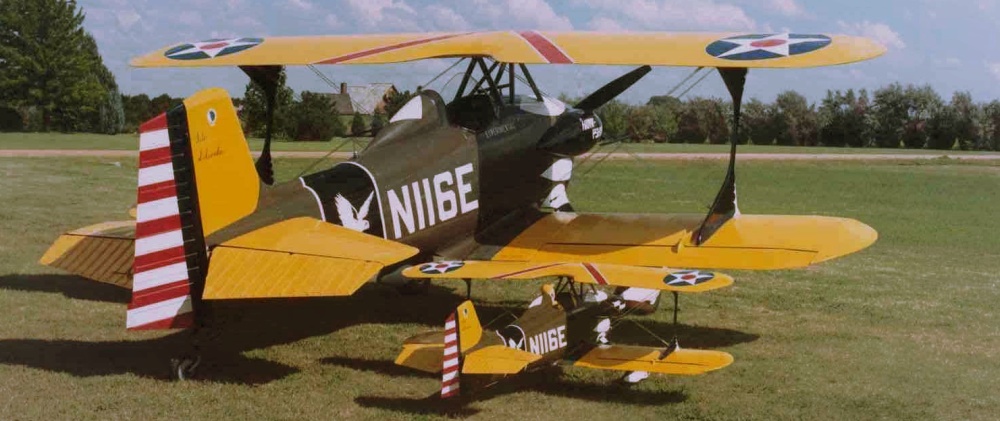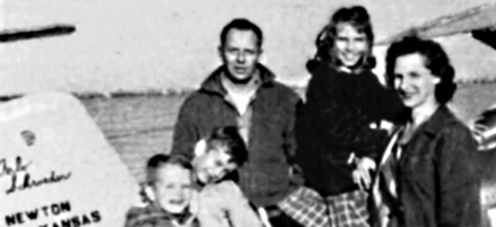Countdown In Kansas - By Kathryn Schroeder
All the countdowns at Cape Canaveral couldn't beat the excitement at the Newton, Kansas Municipal Airport, Feb. 19, when Arlo Schroeder launched his biplane, Hawk-Pshaw, and went into a three mile orbit of the field. The large group of relatives, friends and fellow members of EAA chapter 88 were treated to a top-notch, first flight performance by the flashy little plane which bears a paint job similar to that of the old Army Air Corps Curtiss Hawk P-6E.
From the start of the Continental C-85 engine until the plane was brought in for a neat landing, it proved to be all the pilot had hoped for and his undisguised pleasure was the final seal of approval. As a testimonial on the ease of flying the aircraft, Arlo had logged only 63 hours of flight time when he made the test hop.
The sunny, windless chill of the big day came on the heels of the most miserable experience this homebuilder encountered during his two and a half years on the project. After 3,000 hours of loving labor, he found himself unbelievably in possession of a completed plane, a certificate of airworthiness, the blessings of the FAA, and three days of the worst possible weather. It was a delay that seemed endless. Yet, when the big day finally arrived the anxious spectators were kept waiting at the airport while the pilot calmly watched a 90 minute air show on television.
George Meyer may have known what our family was getting into when he mailed his Little Toot plans in Sept., 1958, but back then we hardly noticed the subtle change as the little biplane began to take us over. Even the fact that the prospective builder stayed up all night admiring the plans, failed to warn us properly. After that he wasted just enough time to assure a wavering wife that the airplane would take only a reasonable amount of money (he undershot by about half), and an even more reasonable amount of time (he missed on that one by 17 months).
Work began in the basement with a maximum of enthusiasm and a minimum of tools. It can honestly be said now that the enthusiasm never waned even as the months stretched into years. As the airplane began to take shape the house shook with hammering and riveting and reeked of zinc chromate, and even the new baby in the family thrived on it all. When the time came to move the aft six foot section of the monocoque fuselage from the basement to the garage, a few friends and skeptics managed to be on hand to supervise the event. The ease of this well planned maneuver made believers of them all.
Our garage filled the two requirements for airplane building. It was there and it was large enough. To provide ideal working conditions our homebuilder installed an air conditioner and later, a heating system, while the car sat out in the Kansas weather season after season.
It wasn't long until the project reached "the first plateau", the stage when the pilot could prop the fuselage on sawhorses and precariously fit himself into the cockpit framework. For obvious reasons, a little time was lost at this point. The biggest time consumer, however, was the fiberglass cowling.
It began with a plaster of Paris cast formed around the carefully wrapped engine. The cowling was made from this mold. Sanding the plaster and then the fiberglass, created the biggest mess of the entire project but the results were rewarding. Fiberglass was also used for the gas tank and for the wheel fairings which were made from molds of Doyn Aircraft conversions of the Cessna 172 nose wheel. As the supply of fiberglass material diminished a major crises arose in the household. With an attitude typical of the species, the experimenter began sizing up the fiberglass draperies in the living room and only the veto power of the spouse saved them from becoming part of the airplane.
Operations moved back to the basement when the wing work began and the whole family got into the act briefly on the sanding and fitting detail. The theory seemed to be that no one was too unskilled or too young to use sandpaper.
There was a big delay about this time when the chief of operations got tangled up in the Shop-Smith and had to take time off from everything while his finger grew back together. There followed some debate as to whether or not the medical bills should be added to the cost of the airplane.
The woodwork on the wings was responsible for a large part of the total construction time but a record may have been set on the covering, rib-stitching and doping. Bob Stephens of Wichita, builder of the Stephens Special seen at many EAA fly-ins, arrived for a visit and brought along a Simon Lagree-type whip to make sure there was no lost motion in finishing the wings. Since he worked harder than anyone, the family was forced to keep pace.
However, if Bob got in a lather, it served him right. He was the character who fanned the embers of a dormant dream into the blaze of action that resulted in this beautiful homebuilt. Today we view Bob with mixed emotions. Should we thank him or ban him from the property? With the wings completed, Hawk-Pshaw was really on its way. The "odds and ends" and "finishing up" categories took several more months before the plane was towed to the airport for final assembly.





